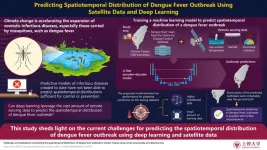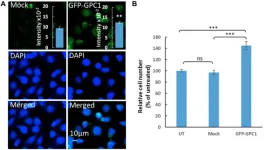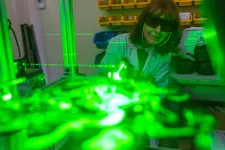(Press-News.org)
Outbreaks of zoonotic diseases, which are those transmitted from animals to humans, are globally on the rise owing to climate change. In particular, the spread of diseases transmitted by mosquitoes is very sensitive to climate change, and Chinese Taiwan has seen a worrisome increase in the number of cases of dengue fever in recent years.
Like for most known diseases, the popular saying “an ounce of prevention is worth a pound of cure” also rings true for dengue fever. Since there is still no safe and effective vaccine for all on a global scale, dengue fever prevention efforts rely on limiting places where mosquitoes can lay their eggs and giving people an early warning when an outbreak is likely to happen. However, thus far, there are no mathematical models that can accurately predict the location of dengue fever outbreaks ahead of time.
To address this issue, a research team including Professor Sumiko Anno from Sophia University, Japan, sought to combine artificial intelligence (AI) with remote sensing data to predict the spatiotemporal distribution of dengue fever outbreaks in Chinese Taiwan. This work, which was published in Geo-spatial Information Science, was co-authored by Hirakawa Tsubasa, Satoru Sugita, and Shinya Yasumoto, all from Chubu University, Ming-An Lee from National Taiwan Ocean University, and Yoshinobu Sasaki and Kei Oyoshi from the Japan Aerospace Exploration Agency (JAXA), Japan.
First, the team gathered climatic data of Chinese Taiwan from 2002 to 2020, including data on rainfall, sea-surface temperature, and shortwave radiation. They also gathered information on the place of residence of all reported dengue fever cases registered in the Chinese Taiwan Centre for Disease Control. This enabled the researchers to prepare a labelled training dataset for the AI model, which should ideally be capable of finding hidden patterns between dengue fever cases and climatic parameters.
The AI model in question was a convolutional neural network (CNN) with a U-Net-based encoder–decoder architecture. “The U-Net model works with remarkably few training images and yields more precise semantic segmentation when provided with the location information,” explains Prof. Anno about the choice of AI model for their study. This well-established design usually performs well in image segmentation tasks, even when trained with few samples. After training the model, the team attempted to validate it using the remaining gathered data.
Unfortunately, the model did not perform as well as the researchers hoped it would. Most of the pixels on the map of Taiwan marked as predicted dengue fever outbreak locations did not match the original data. However, not all hope is lost for this approach, as Prof. Anno highlights: “While most of the predicted outbreak pixels did not overlap with the ground truth, some of them were located quite close to actual outbreak locations. This implies that the spatiotemporal prediction of dengue fever outbreaks using remote sensing data is possible.”
Despite the low accuracy of the AI model, this study brought to light some of the current challenges of using remote sensing data for predicting the spatiotemporal distribution of zoonotic disease outbreaks. The research team believes that using a different model architecture, finding a way of balancing the training dataset, and gathering higher-resolution satellite data could all be promising ways to achieve the necessary performance.
More work will be required before we can use machine learning as a tool to pinpoint potential disease outbreak zones based on climatic data, but we must not falter. “Spatiotemporal visualizations generated by deep learning models could potentially guide the implementation of effective measures against disease outbreaks at the optimal time and location for disease prevention and control,” concludes Prof. Anno, optimistically.
Let us hope further studies in this field help us keep people safe from zoonotic diseases soon.
Reference
【Title of original paper】Challenges and implications of predicting the spatiotemporal distribution of dengue fever outbreak in Chinese Taiwan using remote sensing data and deep learning
【Journal】Geo-spatial Information Science
【DOI】10.1080/10095020.2022.2144770
【Authors】Sumiko Anno1, Hirakawa Tsubasa2, Satoru Sugita2, Shinya Yasumoto2, Ming-An Lee3, Yoshinobu Sasaki4, and Kei Oyoshi4
【Affiliations】1Graduate School of Global Environmental Studies, Sophia University, 2Chubu Institute for Advanced Studies, Chubu University, 3Centre of Excellence for Ocean Engineering and Department of Environmental Biology and Fisheries Science, National Taiwan Ocean University, 4Earth Observation Research Center, Japan Aerospace Exploration Agency
END
Engineers are harnessing artificial intelligence (AI) and wireless technology to unobtrusively monitor elderly people in their living spaces and provide early detection of emerging health problems.
The new system, built by researchers at the University of Waterloo, follows an individual’s activities accurately and continuously as it gathers vital information without the need for a wearable device and alerts medical experts to the need to step in and provide help.
“After more than five years of working on this technology, we’ve demonstrated that very low-power, millimetre-wave radio systems enabled by machine learning ...
NEW YORK, NY--Columbia researchers have discovered how a genetic defect leads to spinal muscular atrophy (SMA), a critical piece of information about the disease that neurologists have been seeking for decades.
The discovery suggests a new way to treat SMA—a devastating childhood motor neuron disease that affects 1 in 6,000 children. In the most severe cases, and when left untreated, children born with SMA die within the first two years of life.
The researchers also used their finding to develop an experimental therapy that improved survival in mice with severe SMA by ...
“This study was designed to increase the knowledge on the potential of GPCs and in particular GPC1 as a biomarker in cancer diagnosis and prognosis.”
BUFFALO, NY- March 22, 2023 – A new research paper was published in Oncotarget's Volume 14 on March 21, 2023, entitled, “Attenuation of cancer proliferation by suppression of glypican-1 and its pleiotropic effects in neoplastic behavior.”
Glypicans (GPC1-6) are associated with tumorigenic processes and their involvement in neoplastic behavior has been ...
CAMBRIDGE, Mass.—Clean geothermal energy—the heat beneath our feet—has the potential to be cost competitive with other renewables and even fossil fuels if we can drill deep enough to access the mother lode of the resource. That’s according to one speaker at a geothermal conference last month held by the Society of Petroleum Engineers (SPE). Other speakers addressed growing interest in the field by the oil and gas sector, key challenges it faces, and solutions to help solve those challenges.
Geothermal 2023: Realising the Ambition was organized by the Aberdeen, ...
When natural habitats are cleared to make way for cities, roads and agriculture, this often leaves behind “islands” of fragmented habitat that can place species at risk of extinction. Species are at risk when they find it hard to move among habitat patches to find resources and reproduce.
By combining lab experiments and mathematical modelling, researchers at McGill University and the Swiss Federal Institute of Aquatic Science and Technology have found a way to predict the movement of species that could guide conservation efforts to reconnect fragmented habitats.
The ...
Scientists have gained new insights into the part of the brain that gives us a sense of direction, by tracking neural activity with the latest advances in brain imaging techniques. The findings shed light on how the brain orients itself in changing environments – and even the processes that can go wrong with degenerative diseases like dementia, that leave people feeling lost and confused.
“Neuroscience research has witnessed a technology revolution in the last decade allowing us to ...
PHILADELPHIA – The members of the American Association for Cancer Research (AACR) have elected Patricia M. LoRusso, DO, PhD (hc), as the AACR President-Elect for 2023-2024. LoRusso will become President-Elect on Monday, April 17, during the AACR’s Annual Business Meeting of Members at the AACR Annual Meeting 2023 in Orlando, Florida. She will assume the Presidency in April 2024 at the AACR Annual Meeting in San Diego, California.
LoRusso is a professor of medicine (medical oncology); chief of experimental therapeutics; associate cancer center director for experimental therapeutics; and leader of the Phase I disease aligned research ...
EMBARGOED FOR RELEASE UNTIL 4 P.M. ET, WEDNESDAY, MARCH 22, 2023
MINNEAPOLIS – People who have low bone density may have an increased risk of developing dementia compared to people who have higher bone density, according to a study published in the March 22, 2023, online issue of Neurology®, the medical journal of the American Academy of Neurology. The study does not prove that low bone density causes dementia. It only shows an association.
“Low bone density and dementia are two conditions that commonly affect older people simultaneously, especially as bone loss often increases due to physical inactivity and poor ...
EMBARGOED FOR RELEASE UNTIL 4 P.M. ET, WEDNESDAY, MARCH 22, 2023
MINNEAPOLIS – A new study has found that people with epilepsy have an increased risk of early death and the increased risk varies depending on where they live, the number of medications they take and what other diseases they may have. The study is published in the March 22, 2023, online issue of Neurology®, the medical journal of the American Academy of Neurology.
“Our research found an increased risk even among those who do not have ...
Air flow in a room can impact the transmission of viruses like COVID-19.
A Texas A&M AgriLife Research scientist is studying how heating, ventilation and air conditioning, HVAC, system configurations and building designs could mitigate the spread of microorganisms, including viruses, that are detrimental to human health.
Maria King, Ph.D., director of the Center for Agricultural Air Quality Engineering and Science in the Department of Biological and Agricultural Engineering, recently received a $400,000, two-year National ...





